7 Practical Ideas to Improve Employee Engagement (Even in Hybrid Workplaces)
“I'd love to talk to you in person.”
Jack could sense Laura’s shaky voice on the other end of the line, so he obliged.
The next day, Laura made her way to Jack’s office in the heart of San Francisco. She worked remotely and could communicate via email or chat. But for over two months, Laura insisted on talking to Jack one-on-one.
“I’ve thought about this for several months... and don’t know how best to say it. I, I.., I know it’s the last thing you expect to hear from me right now…
“I, I.., I’ve accepted an offer by ACME Corp.,” Laura managed to voice out.
She was the most productive employee on the team Jack managed. What’s more? Laura was one person Jack considered pivotal to achieving his team’s (and company’s) goals.
But the widening employee engagement gap between team members and Jack, their manager, had become a problem for Laura.
In her words, “I’ve thought about this for several months…”
Now, let me ask you. Who is more responsible for this problematic variance in employee engagement that causes top talent to jump ship?
Managers are.
Gallup’s study confirms this. It found that managers (sorry, I have to call you out) cause a whopping 70% of the variance in employee engagement.
But there’s a solution to this problem. And it isn’t far-fetched.
The solution starts with listening closely to team members under your watch.
And most importantly, continuously measuring how engaged they really are. In other words, track your team’s pulse always.
Jack Welch, the renowned CEO of GE, agrees.
Welch noted employee engagement as the first thing managers and organizations craving success must measure:
There are only three measurements that tell you nearly everything you need to know about your organization’s overall performance: employee engagement, customer satisfaction, and cash flow. It goes without saying that no company, small or large, can win over the long run without energized employees who believe in the mission and understand how to achieve it.
Track, measure, and improve employee engagement with automated team pulse surveys.
Taking Welch’s timeless quote to heart is a must for managers who desire to lead great teams to success. That’s because constantly measuring employee engagement, as he recommended, is your first step to improving it.
And that’s the aim of this guide.
I’ll share practical ideas on how to improve employee engagement in the workplace. Specifically, you’ll see how achieving this is easy with team pulse surveys.
Table of Contents:
What Is Employee Engagement?
Tackling an important issue starts by defining it squarely.
And this is so true for a critical one like employee engagement, where disengaged employees make errors at a 60% higher rate.
But you know why it gets so bad?
Managers don’t notice it going south until they start feeling its backlash. As a manager, you must track, measure, and ensure engagement levels stay positive at all times.
Take Laura, the fictional character I intro’d this article with.
Her decision to leave Jack, her manager, didn’t happen overnight. It rarely does. Loyal people like Laura start nursing the idea to jump ship as engagement shrinks between their manager and team members.
If Jack kept closer tabs with Laura (and the rest of his team), maybe he would’ve noticed the emotional strains building up.
But he didn’t and lost her to a competitor.
All these show employee engagement is more of an emotional thing.
And the definition by Ben Aston, Founder of People Managing People, proves it:
Employee engagement can be defined as a situation where an employee is emotionally invested in their company. This means that the employee cares whether the company succeeds, will defend it when it is criticized and approaches their work with enthusiasm.
A quick point you should squeeze out of this definition is:
Most employee engagement problems start with low levels of emotional attachment to you–the manager, the team you manage, and the company.
Harvard Business Review’s Elad N. Shaf notes that one area such emotions begin to deteriorate is when managers don’t give frontline employees a voice.
He (and two other experts) wrote:
Managers do not always promote employees’ ideas. In fact, they can even actively disregard employee concerns and act in ways that discourage employees from speaking up at all.
In other words, to improve employee engagement, regard concerns raised by those you manage. Also, make efforts to query what’s on their minds.
An excellent way to do both is by tracking your team’s pulse with simple, automated email blasts like this:
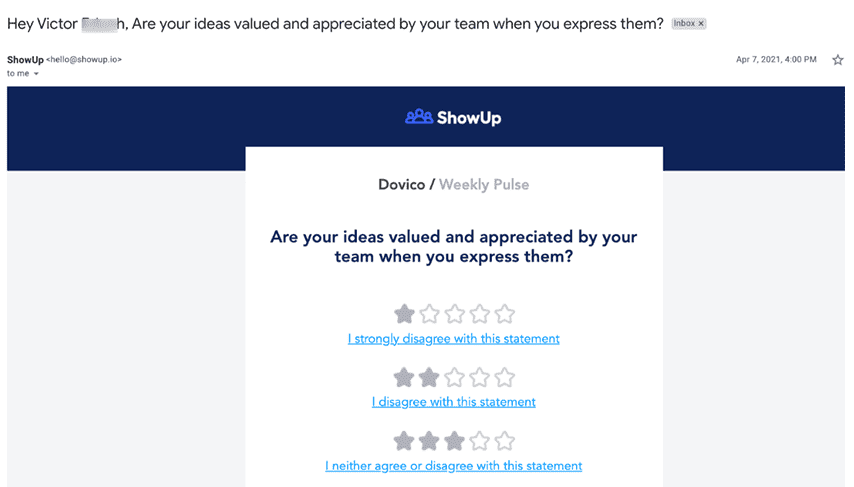
What Is a Team Pulse?
A Team pulse is a measure of what employees think and feel about you–the manager, teammates, and the company at given periods.
Think of how we quickly check if a loved one has a fever.
If you’re like most people, the first thing you’ll do is place your palm on their forehead or neck to sense their temperature, right?
You can liken that caring act of love to team pulse.
But in the context of improving employee engagement, you shouldn’t wait until team members mention (or until you notice) symptoms.
You should regularly check how the people you manage feel.
That’s something most companies and managers don’t do. But employees wished managers and organizations did it more often.
A study by Achievers proves this.
According to the research, more than 58% of employees wished their companies conducted employee engagement surveys more often.
If you grant employees this wish for more frequent surveys, you could get them more engaged. As Ben Aston observed, doing this leads to bigger wins.
Engaged employees are willing to accept change, and offer solutions to challenges. They become the people that your company relies on.
But what’s the connection between team pulse and increasing employee engagement? And does measuring team pulse affect team engagement?
Let’s see.
How Does Tracking Team Pulse Increase Employee Engagement?
Recall our fictional character, Laura, who ditched her manager.
As we saw, the decision to leave started boiling up several months before she eventually made up her mind. It’s logical to imagine her engagement level with team members and on the job also dropped during this period too.
But Jack, her manager, didn’t notice.
In most cases, once top talent declares the intention to leave, that’s when managers begin to connect moments their attitudes indicated they were less engaged.
You can avoid such (and increase engagement) by tracking your team pulse.
Let’s highlight a few data points proving this.
First, 70% of workers said being empowered to succeed was vital in boosting their employee engagement levels. This finding by SHRM shows the more you empower employees, the more you can boost engagement levels.
But are managers listening or conversing with employees enough to uncover how to empower them?
Not really.
According to Gallup, employees said 80% of managers don’t converse with them in at least six months on achieving their goals.
By tracking your team’s pulse, you can uncover what empowers them. Tracking team pulse is also a great way of conversing with employees at scale.
It gives you a standard guidance system that ensures team alignment, leading to improved engagement levels.
Charisse Fontes, Consultant & Founder of Culture Circle, highlighted these connections.
In her words:
A great way to ensure alignment is to have a standard guidance system that universally agrees with everyone. This guidance system has to be at the forefront of any decisions or strategy that involves enlisting others. This, paired with accountability and open respectful communication, will help align everything from the top to the bottom and all the important areas in between.
Tracking your team’s pulse is like having a standard system for open, respectful communication between you and employees. Doing this is possible via weekly or bi-weekly automated team pulse surveys.
And that’s where employee engagement survey software like ShowUp comes in.
Increase Employee Engagement with Automated Team Pulse Surveys
ShowUp automates team pulse surveys for pitch-perfect employee feedback.
For instance, assume you wanted to know how the changes you make to policies affect your team, so you could use this insight to improve engagement.
With ShowUp, you can achieve this in a few button clicks, starting with an automated email blast to all your employees like this one:
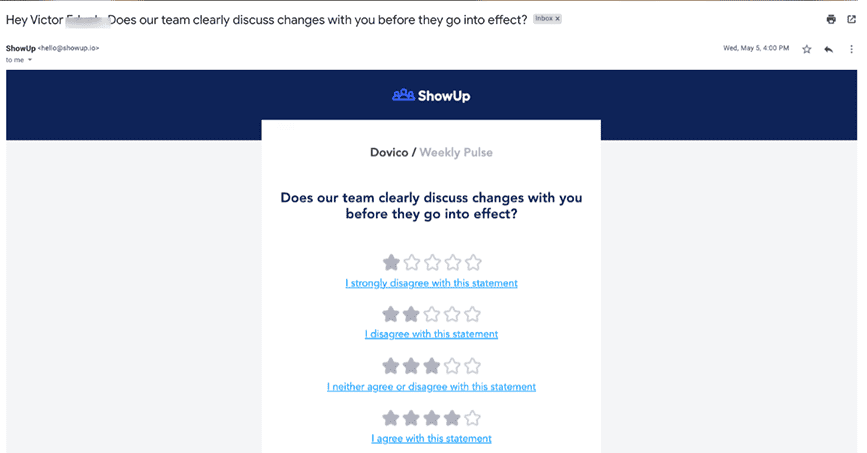
These surveys are conversational.
Keeping it this way helps to get employees emotionally invested and increases participation.
At the same time, it reassures them of anonymity. This fosters trust that you (or other managers) won’t use their views and opinions against them:
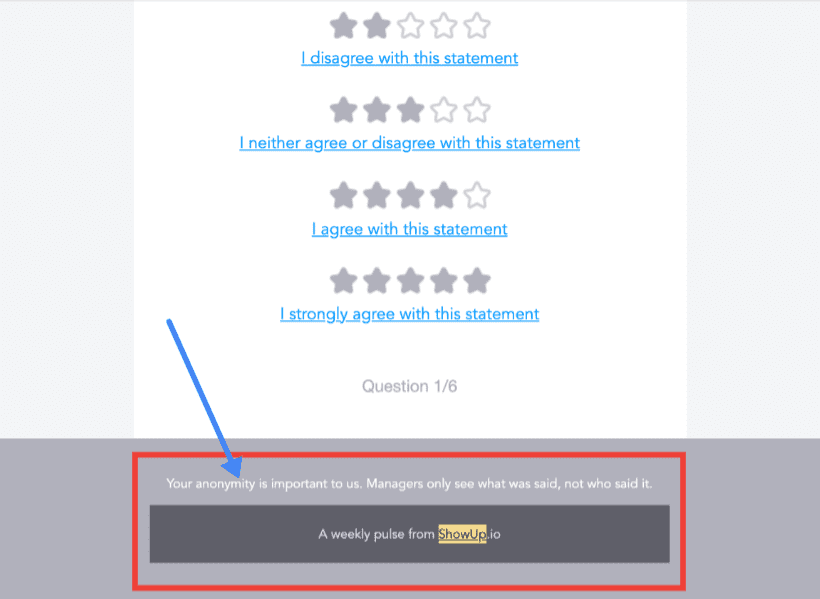
It’s also easy for your employees to complete these pulse survey questions.
And that’s because ShowUp smoothly transitions them to complete your survey once they click to answer the first question in your email blast:
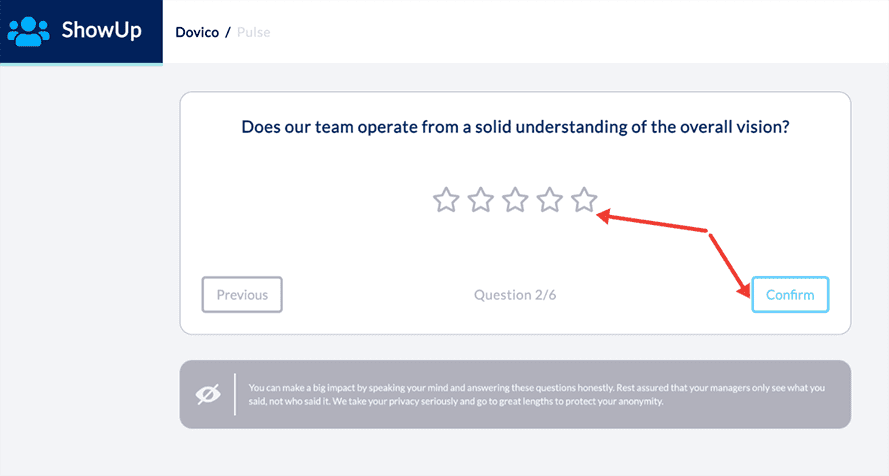
ShowUp also helps you pinpoint areas that need your attention.
Our software collects all the feedback, crunches the data, and displays it with insights on areas you can work on to improve engagement in your workplace:
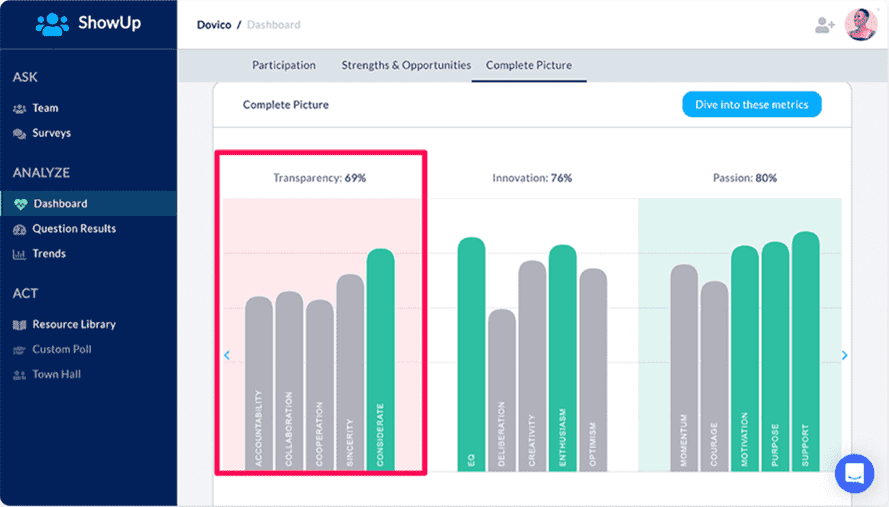
Based on the screenshot above, Transparency, one of the six traits ShowUp measures, is the lowest in the team with this dashboard.
If this was your team, and your goal was to improve engagement, ShowUp already did the heavy lifting on specific areas you should focus on.
It also gives you the resources to take action:
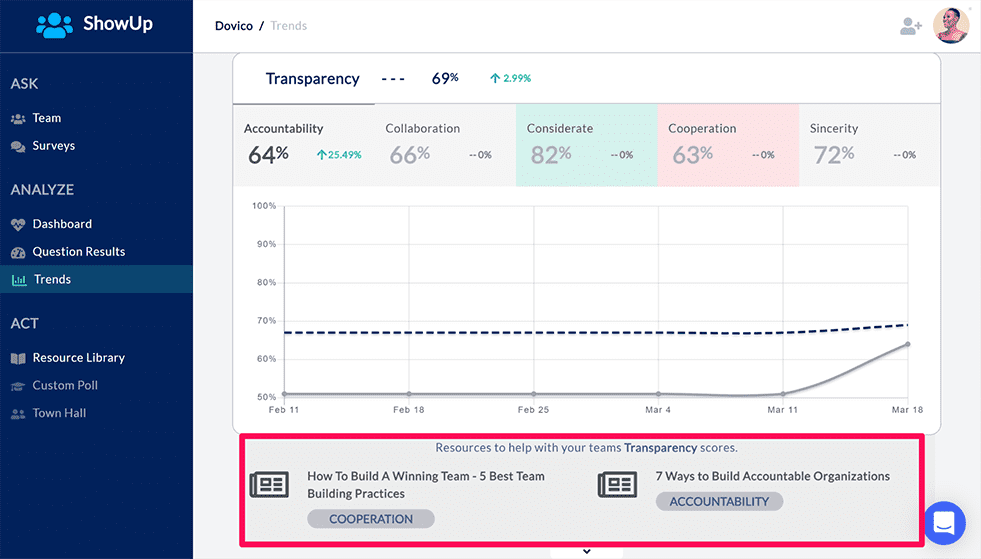
Track, measure, and improve employee engagement with automated team pulse surveys.
7 Ideas to Improve Employee Engagement (Even in Hybrid Workplaces)
Knowing your team’s pulse at all times is at the heart of improving an employee engagement strategy.
It helps you to spot issues before they go beyond repair.
Besides making sending out automated team pulse surveys a breeze, software like ShowUp also gives you the resources to act on feedback.
However, there are other tactics you can use to supplement your employee engagement efforts.
Let’s briefly discuss seven vital ideas.
Spell Out Your Company Culture & Values
By saying you should spell out your company culture and values, I’m insisting that you must have a strong one (if you don’t) worth spelling out.
And that’s because it affects employee engagement.
Research by Columbia University confirms this.
The study found that the job turnover rate for a company with solid company culture was a mere 13.9%. Compare this low figure that goes way up to 48.4% for an organization with weak company culture & values.
Other findings show close ties between culture and employee engagement.
For instance, as per research by Deloitte, 78% of HR leaders observed company culture and engagement as their biggest challenges.
In other words, if you don’t declare your company culture, you’ll likely also struggle with employee engagement.
And that’s because once spelled out; employees can understand what’s expected of them. They can connect with your values, feel involved when they play their part, therefore, feeling more engaged at work.
Be Transparent
Creating workplace transparency is essential to employee engagement.
To make sense of this, put yourself in the shoes of your employees for a second. Would you be engaged in a workplace where there’s no sincere, open communication?
I doubt.
As a manager, a surefire way to improve the engagement you expect from employees is to be transparent. Being transparent makes the teammates you manage to see you as a genuinely honest and sincere person.
It’ll make employees share ideas with you freely.
Transparency will also make them more considerate and committed to achieving company goals. This commitment, in turn, boosts collaboration and effective communication among team members.
All of these transparency-related traits affect employee engagement.
And that’s why ShowUp helps you track them as essential team pulses needed for more engaged workers:
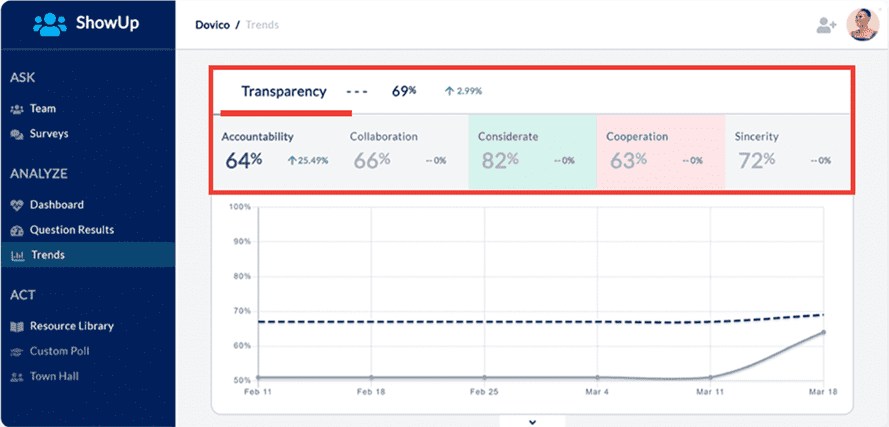
Hire (and Onboard) Thoughtfully
As a manager eager to increase employee engagement, onboarding new hires shouldn’t stop when they’ve signed the paperwork.
In short, it should start there.
Amber Hyatt, a former Director at SilkRoad, outlined how to onboard thoughtfully for increased employee engagement.
A well-designed, fun, and engaging onboarding process has a significantly greater effect on employee engagement and retention when compared to the old-school mentality of one-day orientation.
Onboarding is how you integrate new hires into your company culture.
You should take it seriously.
Because when you onboard well (and by that, I mean thoughtfully), new employees will be happy to blend in, engage more with others, and work collaboratively to achieve set goals.
Recognize (and Reward) Contributions
Employee recognition leads to employee motivation.
In short, there’s strong evidence that if you recognize (and reward) contributions by employees you managed, you’ll get more committed and engaged.
Research by SurveyMonkey & Bonusly provides this evidence.
In the study, 63% of American workers said they wouldn’t search for new jobs as long as their efforts are recognized by management.
That finding makes connecting the dots between recognizing (& rewarding) employees’ contributions and engagement straightforward.
I’ll use you, for example.
If I recognized your contributions, you’d be more committed to doing more, right? Don’t you think this commitment will increase the chances of you engaging more with other employees to achieve bigger targets (and get more recognition)?
I bet it will.
The same pattern applies to you and the employees you manage. Recognize their efforts, and not only will you improve engagement, but employee retention too.
Spot (and Remove) Bad Eggs
Sometimes what’s on an applicant’s resume differs from who they are.
An employee may have all the qualifications and experience you desire in a given position. But you’ll be so wrong to assume that alone will account for their personal ethics.
They don’t.
Some employees are toxic, simple, and short.
They cost you time, money, retention headaches, and have a negative impact on employees. The longer they stay in your team (and company), the more your culture suffers.
And the more your culture and engaged workforce suffers from their bad behavior, the more engagement between you, the manager, and employees will shrink.
In short, as per research by Harvard Business School, 38% of hardworking, engaged employees will “intentionally decrease” their quality of work if there’s a toxic teammate in their midst.
In other words, toxic employees do more harm than shrinking the level of engagement across your entire team.
So, do the right thing.
Take a moment to spot (and remove) bad eggs in the team you manage.
Doing this will do more than boost employee engagement. It will get others to stay longer and saves you associated retention costs.
Don’t Treat Employees’ Wellness Passively
In your quest to improve employee engagement, there’s a limit to how much you can do in the workplace environment.
The truth is that most latent issues that cause employees to be disengaged start in their personal lives. To solve them, you need to care if things are going well in their personal lives.
In a podcast hosted by Author & Business Advisor, Jennifer McClure, she noted how employee wellness touches on personal life and engagement.
She quoted her guest, Laurie Ruettimann, who said:
I’ve never dealt with someone who was chronically late at work that didn’t have something going on in their personal life that was driving some of those attendance issues. For me to just sit there and blather on about an attendance policy was a failed way to solve that problem. We had to drive in deeper. And it’s not just attendance. It’s attention, its attitude, its engagement. All of this doesn’t start at work, it starts at home. That’s what I believe.
Laurie’s belief shows “Health is Wealth” applies here, too.
To hit company goals and new revenue milestones, AKA, build wealth, you need healthy people. This means taking the personal well-being and mental health of the team you manage seriously.
Doing this has its rewards, as per research by Gallup.
In the study, 62% of highly engaged employees felt their work positively affected their physical health. The figure was a mere 22% for actively-disengaged employees.
Have a Continuous (Anonymous) Feedback System
You can implement all ideas listed above and still have a disengaged workforce.
Employees are human beings. And human beings change from time to time. Since this change is only permanent, you should also adjust your strategies and tactics to bolstering engagement.
But how can you do this?
Through a continuous (anonymous) feedback system.
The good thing is that employees expect this kind of frequent feedback too. In Bonusly’s 2020 survey, a whopping 93% of respondents who felt they received adequate feedback were highly engaged employees.
On the other hand, only 41% of respondents who didn’t receive continuous feedback were highly disengaged.
These findings tell us two things.
One, failure to listen continuously to employees for frequent feedback, and you’ll miss opportunities to address minor issues that cause disengagement.
Also, the kind of feedback employees want today isn’t the long-used yearly annual surveys. Annual surveys aren’t frequent enough so that they won’t work in today’s fast-paced business climate.
You need a system to check in on your team’s pulse weekly or bi-weekly.
Better if this is via bit-sized surveys that tracks, measures, and gives you real-time insights on low engagement areas you should focus on.
Better if these surveys are anonymized, so employees participate without fear or favor. And automated so that you can save yourself excessive manual labor.
The good news?
Those excellent features are all in ShowUp’s team pulse survey software.
Conclusion: Improve employee engagement with team pulse surveys
To conclude, let’s revisit Laura, the talented employee who ditched her manager, Jack, at the beginning of this guide.
Unfortunately for Jack, after she left, other top employees left, too.
They all left because engagement between him and other employees continued to deteriorate in the team.
But Jack, like most managers, takes the blame.
And that’s because if he listened closely with more frequent feedback, he would’ve spotted the underlying issues before it went sour.
For instance, he would’ve identified (and addressed) the issue of top employees feeling he wasn’t discussing the changes he implemented:
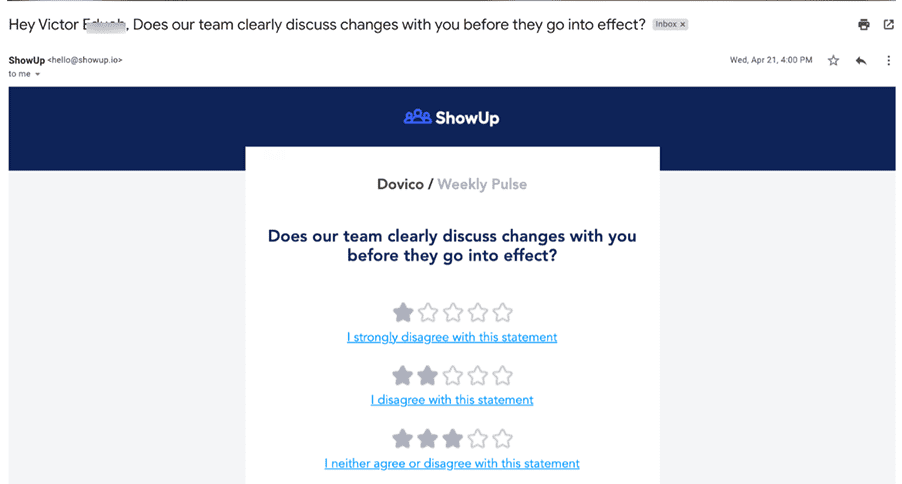
Also, he would’ve known when Laura and disengaged employees felt he wasn’t prioritizing politeness on the team:
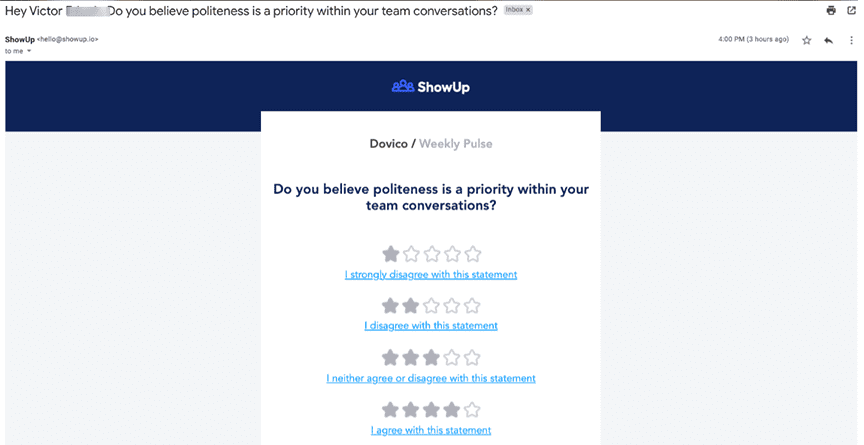
As you can imagine, these are pertinent issues Jack, like most managers, could address easily.
But because he didn’t have a team pulse survey tool to track, measure, and improve little things that affect his employees’ engagement, he couldn’t.
Don’t be like Jack.
Don’t wait until low levels of employee engagement go beyond repair. Achieving your organizational success needs engaged employees.
Get a team pulse survey tool.
With it, you can track, measure, and get insights to increase employee engagement in a dashboard on a regular basis:
Get ShowUp.
